Ireland: Countries IN Profile
After gaining independence from the United Kingdom in 1922, the Republic of Ireland experienced almost 70 years of violence and unrest, fueled by nationalism and religious conflict. Ireland is a small country covering roughly 27,000 square miles with a population of 4.5 million. It joined the European Community in the first round of enlargement in 1973, alongside Denmark and the United Kingdom.1 At the time of its membership, Ireland was the poorest country in the European Community; however, 30 years of rapid growth and development propelled the country to become one of the wealthiest states in Western Europe, with its GDP per capita exceeding the average for the Euro area. In 2009, Ireland was ranked fifth on the United Nation’s Human Development Index, the highest rank amongst the 27 members of the EU and above the United States which ranks 13th (see Table 1).
Table 1: UN Human Development Index (HDI), 2007
| HDI Measures | Ireland | United States |
|---|---|---|
| HDI Value | 0.965 | 0.956 |
| Life Expectancy at Birth (Years) | 79.7 | 79.1 |
| Education Index* | 0.985 | 0.968 |
| GDP Per Capita (PPP U.S. Dollars) | $44,613 | $45,592 |
*Measures a country's relative achievement in both adult literacy and combined primary, secondary and tertiary gross enrollment.
Source: Human Development Reports
The period of economic expansion saw numerous U.S. information technology companies such as Intel, Dell and Microsoft establishing operations in the country. A number of high-profile Indiana-based businesses have also invested in Ireland, including the Cook Medical Group,2 Eli Lilly,3 Zimmer Inc.,4 Hill-Rom Inc.5 and Symmetry Medical.6 Currently more than 600 U.S. firms operate in Ireland, employing around 90,000 individuals. In 2009, the estimated value of American investment in Ireland stood at $146 billion.7
While Ireland’s economic performance has been impressive, like most countries it is currently attempting to steer its economy through difficult times. The collapse of the domestic housing market combined with recessions in the country’s major trading partners led to a dramatic reversal in Ireland’s fortunes. While a return to positive growth is forecast for 2011, the rate of growth can be described as meager at best (see Figure 1). It remains to be seen whether the Irish government and the European Union will be able to restore the country’s economy without undermining its competitive advantage.
Figure 1: Annual Change in GDP, 2000 to 2011*
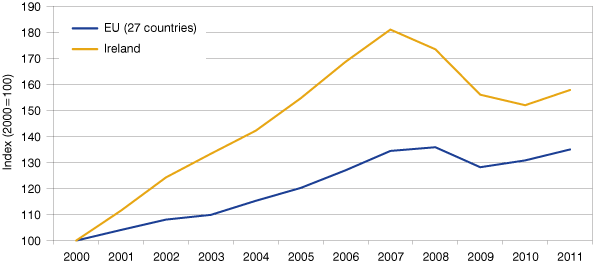
*2010 and 2011 are projections
Source: IBRC, using Eurostat data
Economy
Since 2007, Ireland’s GDP has been falling and is expected to decline further until at least the third quarter of 2010. Seven quarters of negative growth have resulted in substantial unemployment, which is forecast to stabilize at about 14 percent in the third quarter of 2010. At its peak in 2006, the construction industry accounted for some 13 percent of total employment, in contrast to an EU average of just 8 percent. The rapid contraction in the real estate market resulted in a significant drop in construction employment and was likely a major factor contributing to plummeting employment figures across the country.8 As unemployment rose, disposable income and private savings also fell. Instability in the job market has also led to a reverse in migration trends as Irish and foreign workers seek employment outside the country.9
As with many European states in the throes of the recession, the Irish government embarked upon a program to reverse the economic hemorrhaging, including setting up a “bad bank” known as the National Asset Management Agency (NAMA), the purpose of which was to purchase toxic assets from banks operating in Ireland.10 The increase in public spending required to fund NAMA activities combined with falling tax revenues resulted in a rapidly escalating level of government debt. To address this problem, the Irish government cut public services and increased taxes, but even with these measures in place, the government debt-to-GDP ratio is likely to continue to increase (see Figure 2). Ireland has been an attractive destination for foreign capital, but that may change given that the recent direction of fiscal policy may hinder growth by discouraging future foreign direct investment (FDI).
Figure 2: Government Debt as a Share of GDP, 1998 to 2009
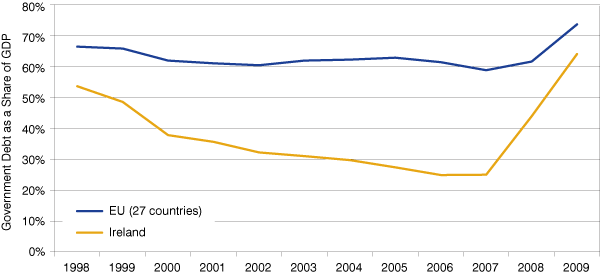
Source: IBRC, using Eurostat data
The pending effects of Ireland's changing fiscal policy on FDI is relevant for Indiana firms with connections in Ireland. For example, in July 2010 ImageStream Internet Solutions based in Plymouth, Ind., announced it will be partnering with Azotel which is based in Cork, Ireland, to produce an innovative network provisioning solution. Both organizations have agreed to continue their association for at least the following year and are currently investigating the possibility of expanding their shared areas of operation.11 It is clear that despite the recent difficulties, Ireland and Irish industry play a noteworthy role in the economy of the Midwest.
Foreign Direct Investment and the Economic Crisis
Since joining the EU in the mid-1970s, Ireland enjoyed a positive inflow of investment from other countries. No doubt investors were in part attracted by Ireland’s corporate income tax rate, which has declined since the early 1980s to almost half the EU average of 23.2 percent12 and the third lowest amongst all member states, after Cyprus and Bulgaria (10 percent in both).13 In 1990, foreign investment began to increase, peaking in 2002 before rapidly declining to its lowest level in more than 30 years in 2005. FDI recovered in 2006 and 2007 but this proved to be unsustainable and disinvestment once again outweighed investment causing FDI to fall by around 200 percent in 2008 (see Figure 3).
Whether this sudden imbalance was a cause or symptom of Ireland’s recent economic trouble is difficult to determine, but what is clear is that these fluctuations in confidence in the Irish economy have had significant ramifications. In July of this year, Moody’s rating agency downgraded Ireland’s sovereign bond rating from Aa1 to Aa2, causing the Irish stock market to fall over the four days following the announcement and the yield on Irish 10-year bonds to rise 8 basis points to 5.51 percent,14 suggesting that country’s troubles are not yet over. In recent months, certain investment banking organizations have begun to group together the European states in which they have the least confidence under the acronym “PIIGS” (Portugal, Italy, Ireland, Greece and Spain). While the usage of this acronym is contentious, the inclusion of Ireland in this group, which, hitherto had consisted exclusively of southern European nations, demonstrates just how far the Irish economy has fallen.15
Figure 3: Net Foreign Direct Investment Inflows to Ireland, 2000 to 2008
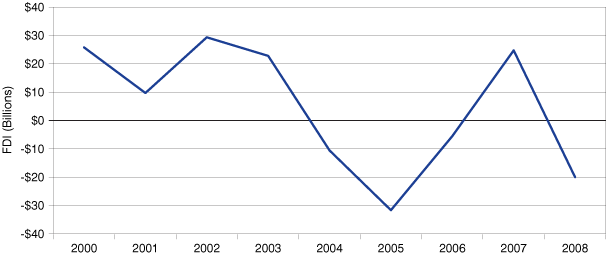
Source: IBRC, using UNCTAD data
In response to this crisis, the Irish government has developed a comprehensive review of its financial sector and plans to implement a number of measures to restore confidence in its economy. According to the most recent report issued by the Irish Central Bank, the collapse of the economy was a result of a relaxed attitude toward the regulation of the financial sector. Consequently, the intended reforms focus on redesigning the regulatory framework and, if effective, they will contribute to the restoration of confidence in the Irish economy.16
Trade
While a relatively small economy compared to other Euro-zone countries, Ireland maintains important trade linkages with the United States. The United States ranks third as a destination for Irish exports.17 In 2009, the largest commodity by far (when measured in dollar value) exported by Ireland to the state of Indiana was organic chemicals, followed by medical and surgical equipment and then pharmaceutical products.
Indiana’s exports to Ireland follow a similar pattern. The largest commodity by dollar value exported from Indiana to Ireland in 2009 was pharmaceuticals, followed by medical and surgical equipment, and then organic chemicals. As Figure 4 shows, these three commodities comprised almost all Hoosier products purchased by Irish businesses.
Figure 4: Indiana's Commodity Exports to Ireland, 2006 to 2009
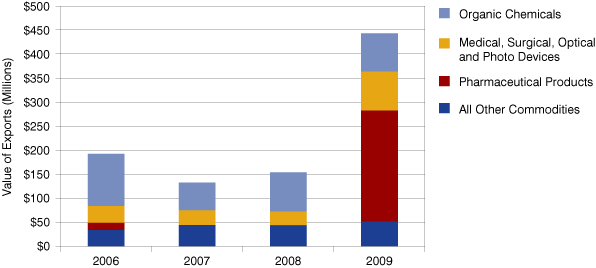
Source: IBRC, using WISERTrade data
The similarity in these leading traded goods reflects inter-dependent industrial sectors in Ireland and Indiana. Perhaps the most interesting feature of Indiana-Ireland trade relations is the recent increase in exports to Ireland from Indiana’s chemical and pharmaceutical industries. This rapid recent increase in trade supports the hypothesis that there is substantial interdependence between the Indiana and Irish chemical industries. Trade data seem to suggest that fluctuations in Indiana’s pharmaceutical exports to Ireland are associated with the variation in exports from a small number of other states, namely California, New Jersey and Massachusetts (see Figure 5). A majority of the world’s pharmaceutical companies have subsidiaries in Ireland, including Indiana’s Eli Lilly, which is about to begin construction on a new $520 million facility.18
Figure 5: Pharmaceutical Exports to Ireland, 2006 to 2009
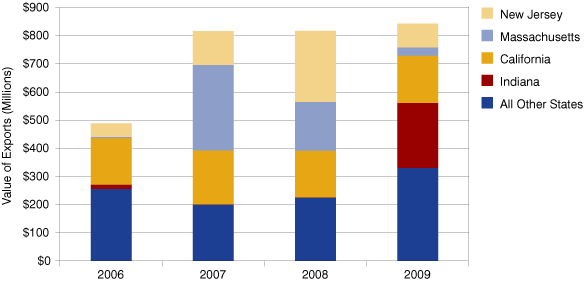
Source: IBRC, using WISERTrade data
Conclusion
Because of the increasing trade and investment flows, Indiana has a significant interest in the fortunes of Ireland. But will the expansion in the pharmaceutical trade between these two regions be sustainable? The U.S. health care reform legislation recently enacted creates many uncertainties about the direction and volume of trade and investment in pharmaceuticals and medical devices between Indiana and Ireland.
The current global recession appears to have temporarily stalled Ireland’s impressive economic growth over the last three decades. There are open questions about the Irish economy’s ability to bounce back given the high levels of public sector indebtedness and the need for the national government to scale back on its expenditures. The pursuit of foreign capital and trade opportunities presented by integrating with Europe has allowed Ireland to emerge as a significant economic actor. Historic and cultural links combined with a common language and favorable government economic policies have made Ireland a key location for many American industries. Although the current situation remains bleak, most Ireland watchers expect the Irish economy will return to growth in 2011. The question is, will the Celtic tiger come back limping or roaring?
Notes
- BBC, “Ireland Country Profile,” March 23, 2010, http://news.bbc.co.uk/2/hi/europe/country_profiles/1038581.stm (accessed June 2, 2010).
- Cook Group, “Medical Manufacturing,”(accessed June 23, 2010).
- Eli Lilly and Company, “Welcome to Lilly in Ireland,” www.lilly.ie/ (accessed June 23, 2010).
- Zimmer Inc., “ Zimmer Facilities,” www.zimmer.com/z/ctl/op/global/action/1/id/131/template/CP/navid/10541 (accessed May 21, 2010).
- Hill-Rom Inc., “Welcome to Hill-Rom Ireland,” www.liko.com/ie/Ireland/ (accessed May 21, 2010).
- Symmetry Medical Inc., “A World of Opportunities,” www.symmetrymedical.com/ (accessed May 21, 2010).
- U.S. Commercial Service, “Doing Business in Ireland,” U.S. Department of Commerce, 2010, www.export.gov/ireland/doingbusinessinireland/index.asp.
- Directorate General for Economic and Financial Affairs, European Economic Forecast (Brussels: European Commission, 2009).
- Directorate General for Economic and Financial Affairs, European Economic Forecast (Brussels: European Commission, 2010).
- Dominic Coyle, "A Shot in the Arm," The Irish Times, June 6, 2008.
- “ImageStream Partners with Azotel for ISP Provisioning Automation,” Business Wire, July 22, 2010, http://eon.businesswire.com/news/eon/20100721006421/en.
- KPMG, "KPMG's Corporate and Indirect Tax Survey 2009," www.kpmg.com, October 19, 2009, (accessed June 23, 2010).
- "Taxation Trends in the European Union," Eurostat News Release, June 28, 2010, https://ec.europa.eu/eurostat/documents/3217494/5718201/KS-DU-10-001-EN.PDF.pdf/bd63fe10-7339-491f-afcb-08bd4c8daa8b?t=1414774976000 (accessed July 29, 2010).
- David Oakely, “Moody's Downgrades Ireland's Rating,” Financial Times, July 19, 2010.
- "PIIGS label too ham-fisted for Barclay's, "The Irish Times, February 6, 2010, Business Today section: 18.
- Irish Central Bank, "Banking Supervision: Our New Approach," June 21, 2010, www.financialregulator.ie/press-area/press-releases/Documents/21 June 2010 - Banking supervision, our new approach - Speech by Jonathan McMahon, ADG for Financial Institutions.pdf (accessed June 23, 2010).
- Central Statistics Office Ireland, “External Trade,” www.cso.ie/en/statistics/externaltrade/ (accessed May 17, 2010).
- Eli Lilly and Company, “Welcome to Lilly in Ireland,” www.lilly.ie/ (accessed June 23, 2010).
Matthew Hutchinson
Research Assistant, Indiana Business Research Center, Indiana University Kelley School of Business
